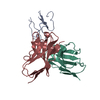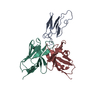+Search query
-Structure paper
| Title | Neutralizing monoclonal antibodies against the Gc fusion loop region of Crimean-Congo hemorrhagic fever virus. |
|---|---|
| Journal, issue, pages | PLoS Pathog, Vol. 20, Issue 2, Page e1011948, Year 2024 |
| Publish date | Feb 1, 2024 |
 Authors Authors | Liushuai Li / Tingting Chong / Lu Peng / Yajie Liu / Guibo Rao / Yan Fu / Yanni Shu / Jiamei Shen / Qinghong Xiao / Jia Liu / Jiang Li / Fei Deng / Bing Yan / Zhihong Hu / Sheng Cao / Manli Wang /  |
| PubMed Abstract | Crimean-Congo hemorrhagic fever virus (CCHFV) is a highly pathogenic tick-borne virus, prevalent in more than 30 countries worldwide. Human infection by this virus leads to severe illness, with an ...Crimean-Congo hemorrhagic fever virus (CCHFV) is a highly pathogenic tick-borne virus, prevalent in more than 30 countries worldwide. Human infection by this virus leads to severe illness, with an average case fatality of 40%. There is currently no approved vaccine or drug to treat the disease. Neutralizing antibodies are a promising approach to treat virus infectious diseases. This study generated 37 mouse-derived specific monoclonal antibodies against CCHFV Gc subunit. Neutralization assays using pseudotyped virus and authentic CCHFV identified Gc8, Gc13, and Gc35 as neutralizing antibodies. Among them, Gc13 had the highest neutralizing activity and binding affinity with CCHFV Gc. Consistently, Gc13, but not Gc8 or Gc35, showed in vivo protective efficacy (62.5% survival rate) against CCHFV infection in a lethal mouse infection model. Further characterization studies suggested that Gc8 and Gc13 may recognize a similar, linear epitope in domain II of CCHFV Gc, while Gc35 may recognize a different epitope in Gc. Cryo-electron microscopy of Gc-Fab complexes indicated that both Gc8 and Gc13 bind to the conserved fusion loop region and Gc13 had stronger interactions with sGc-trimers. This was supported by the ability of Gc13 to block CCHFV GP-mediated membrane fusion. Overall, this study provides new therapeutic strategies to treat CCHF and new insights into the interaction between antibodies with CCHFV Gc proteins. |
 External links External links |  PLoS Pathog / PLoS Pathog /  PubMed:38300972 / PubMed:38300972 /  PubMed Central PubMed Central |
| Methods | EM (single particle) |
| Resolution | 2.6 - 3.0 Å |
| Structure data | EMDB-36368, PDB-8jkd: EMDB-36406, PDB-8jlw: EMDB-36407, PDB-8jlx: |
| Source |
|
 Keywords Keywords |  VIRAL PROTEIN / CCHFV / VIRAL PROTEIN / CCHFV /  envelope protein / postfusion / envelope protein / postfusion /  Bunyavirus / Bunyavirus /  antibody / glycoprotein C antibody / glycoprotein C |
 Movie
Movie Controller
Controller Structure viewers
Structure viewers About Yorodumi Papers
About Yorodumi Papers











